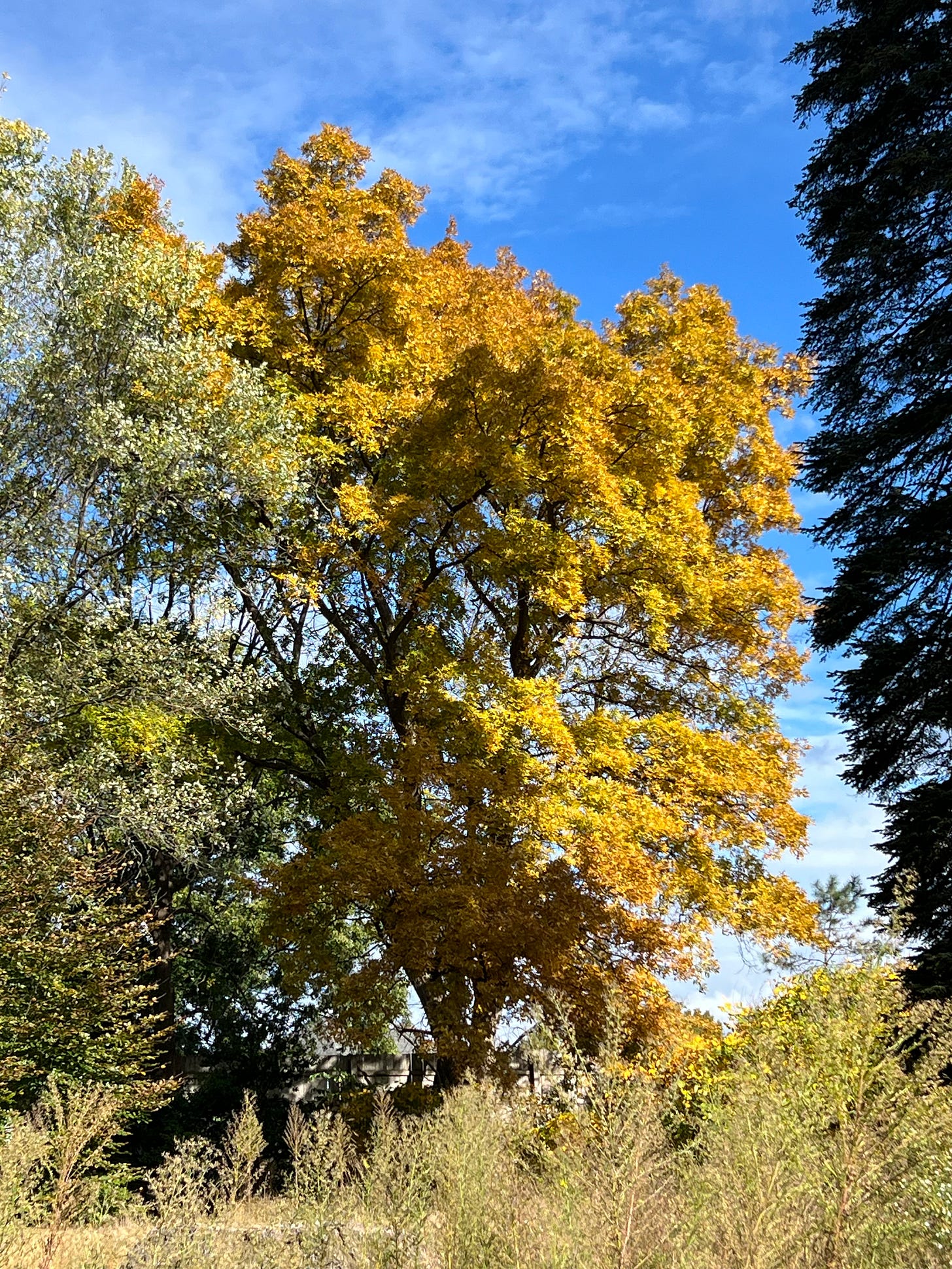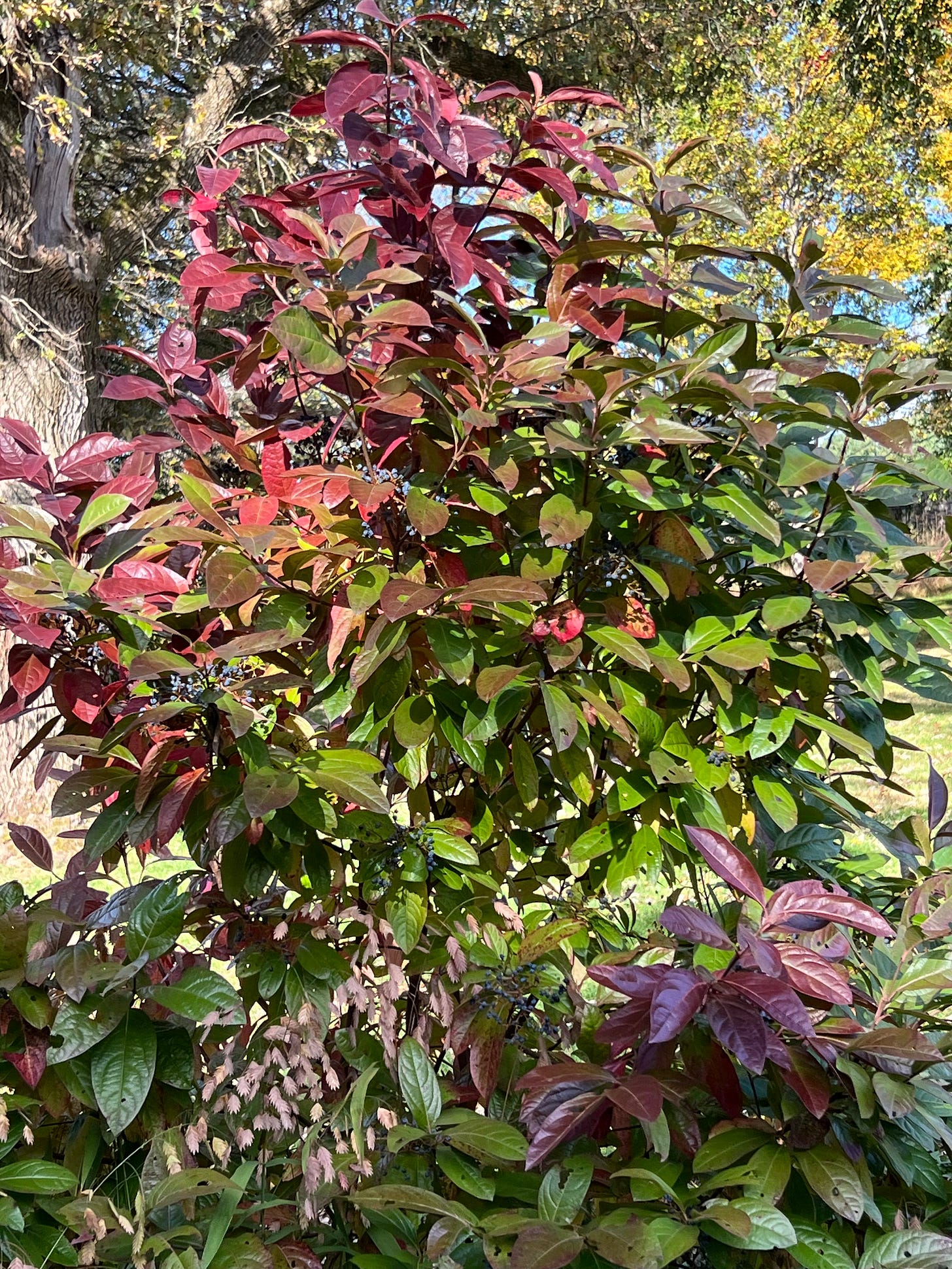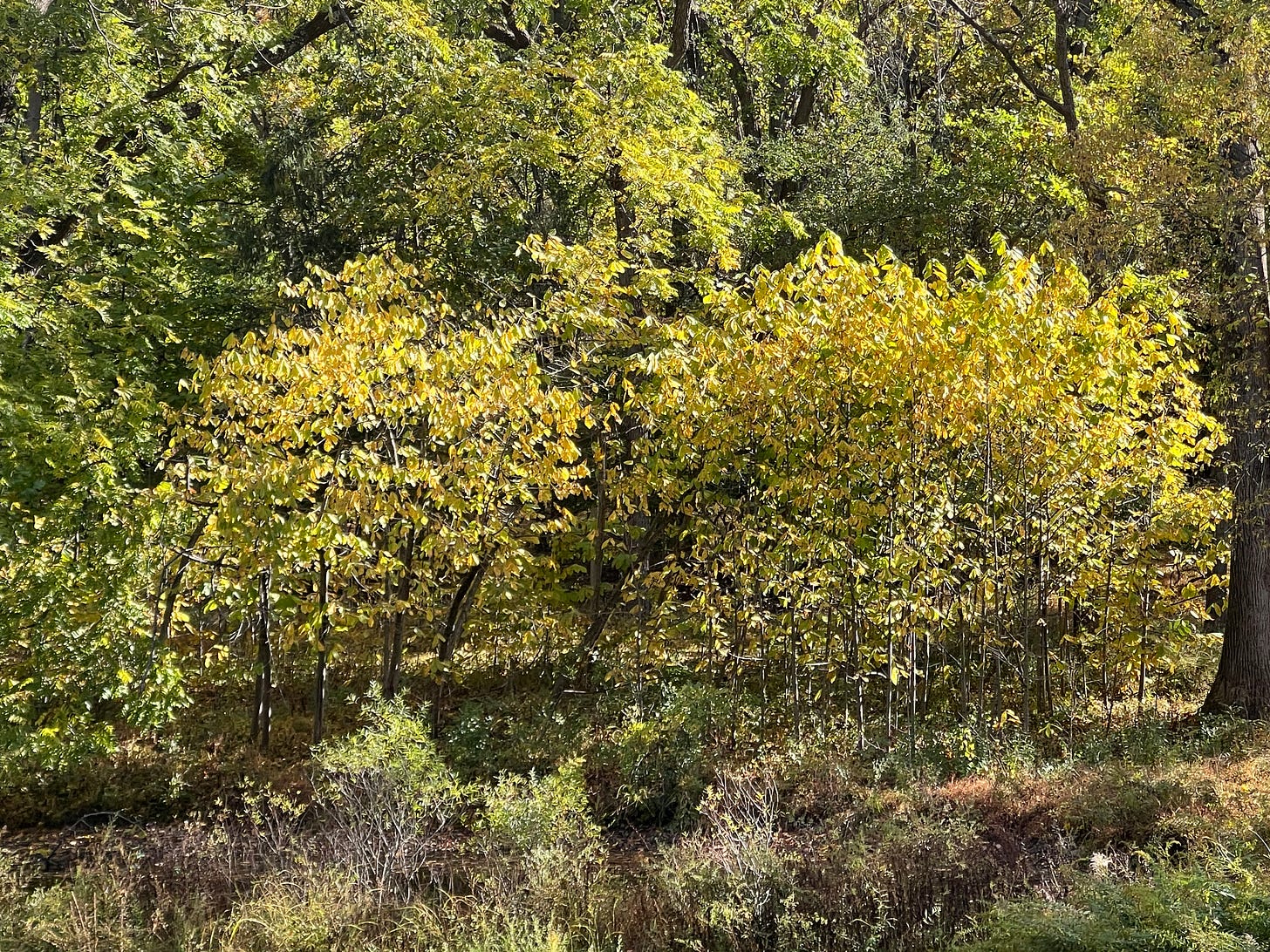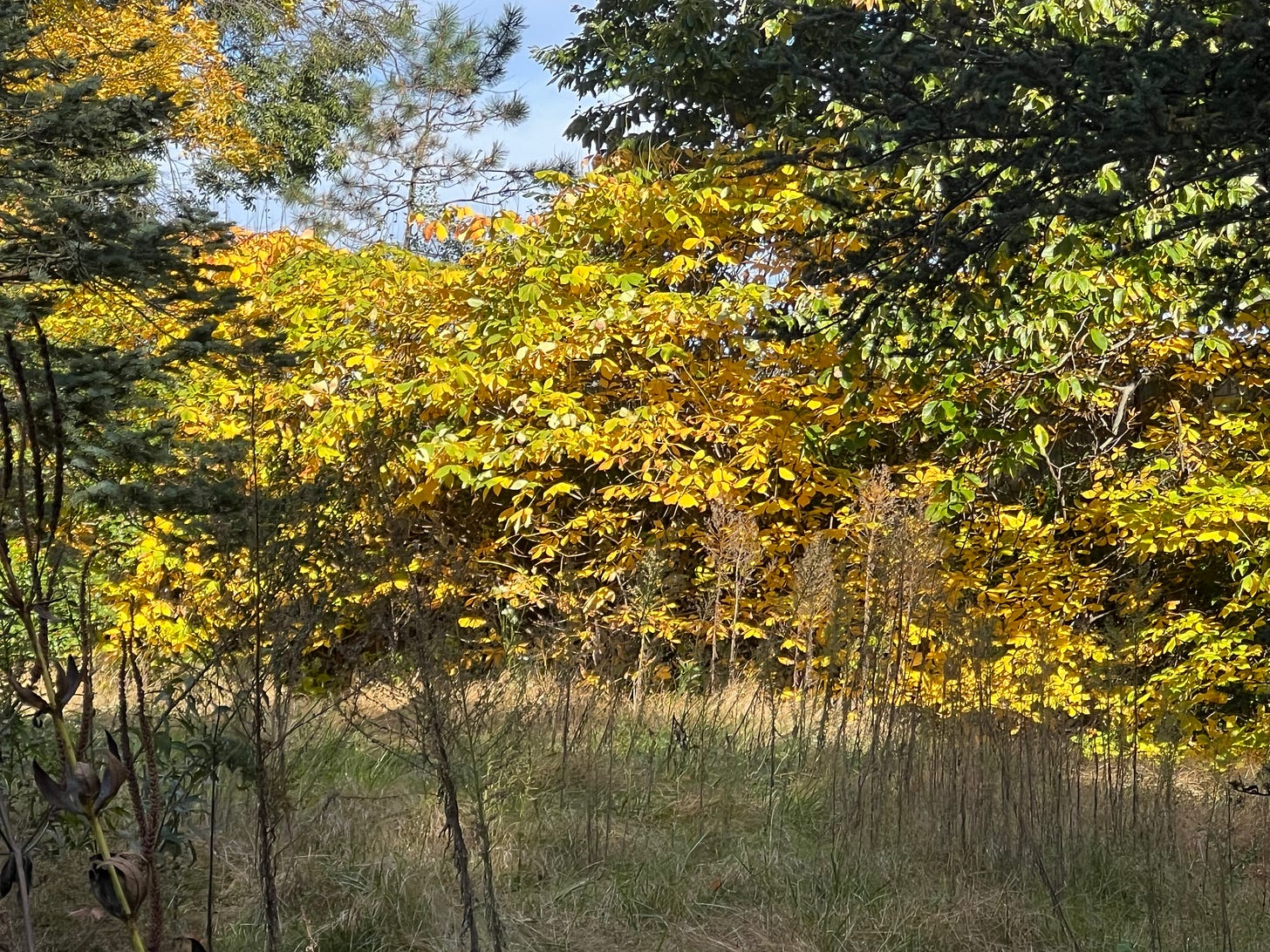Saving Bees in Spring Meadows
Puddock Hill Journal #106: October finds me already fretting over spring cleaning.
A publishing note. I have tried hard to consistently deliver this newsletter weekly on Fridays, except in winter, when it’s more sporadic. Last week, I failed, and other projects competing for my time may conspire for a spotty publication schedule for the rest of this year.
My apologies about that, but Puddock Hill goes on. There will always be something to write about when time allows.
No frost yet but the jewelweed (Impatiens capensis) is down to bare fleshy stalks, plants are browning in the meadows, and black walnuts (Juglans nigra) pelt the ground with regularity. My thoughts turn toward…
Spring?
Yes, spring. I’ve been reading the usual seasonal exhortations against cleaning up too much (I even wrote some myself) and wondering whether even our March brush hogging has been happening too soon.
Most recently, I revisited Douglas Tallamy’s book Nature’s Best Hope. He writes of native bees who nest in the hollow stems of native herbaceous perennials. It’s important to understand their life cycles:
Stems of many herbaceous plants such as goldenrods, blackberries, giant ragweeds, and native hydrangeas are essentially hollow except for a loose fibrous material that bees can easily remove. These cavities make perfect nesting sites. Mason bees, small carpenter bees, and small resin bees will tunnel into the stem, remove the pith from a section several inches long, and then construct a sequence of cells starting at the end of the cavity farthest from the entrance hole. Each cell is packed with pollen, upon which the bee lays a single egg. She then seals off that particular cell and starts to provision the neighboring cell. In this way, the stem contains several developing larvae at once, each spread a day or two apart from neighboring larvae. When development is complete, each larva pupates within the cell. If it is early summer, the young adult will emerge from its cell by chewing a hole directly to the outside, where it begins its search for a mate to start its own family. If a larva matures at the end of the season, the resulting prepupa will stay within its cell all winter, complete its development early in the spring, and emerge as an adult as soon as flowering plants are in bloom.
Tallamy goes on to the usual (and valid) concern with regard to fall cleanup:
In terms of bee conservation, there is a common theme here. Bees cannot nest or overwinter in our yards unless we provide what they need to do so…. Our fall cleanup is particularly hard on bee populations; the senescing stems of black-eyed Susans, penstemons, sunflowers, and all of the other perennials we are so anxious to cut back after they have bloomed are where pithy stem nesters are hoping to spend the winter…. The social edict to neaten up is often in direct conflict with the needs of our native bees.
Here at Puddock Hill, we try to limit cleanup of the planting beds around the house, but their contents pale in comparison to what grows in our meadows and woodier areas. It’s the meadows I worry most about just now—not fall cleanup but spring. We need to fight invasive plants, which usually stay greener longer into fall and start growing earlier in spring than most natives, as well as eliminate some native trees from meadows in order to keep herbaceous meadow plants thriving. But by cutting in March—as we’ve generally done—do we risk destroying bee life just before the insects are ready to get their start?
I don’t know for sure. One can find a lot of guidance related to meadow mowing that only accounts for early fall pollination without taking account of overwintering bees. (Please, please, please do not mow your meadows in fall!) The best consensus I can find about giving bees the chance for their first pupation in spring suggests waiting for consistent daytime temperatures of 50° F. This can be early March where we live, but it isn’t always.
The main reason to fret about these things is that insects are a critical part of the ecology that sustains us, and they are in deep trouble here and all over the world, with 40 percent of species considered at risk of extinction by the Intergovernmental Science-Policy Platform on Biodiversity and Ecosystem Services (IPBES).
A September paper published in Ecology found a decline in insect abundance in Colorado’s subalpine meadows of an astonishing 72.4 percent over the past twenty years. “In a relatively pristine ecosystem, insects are declining precipitously, auguring poorly for this and other such ecosystems that depend on insects in food webs and for pollination, pest control, and nutrient cycling.”
At every level of action, we all must do our part to arrest this decline.
While many factors figure in the insect apocalypse, last year, a study published in CABI Reviews (CABI stands for Centre for Agriculture and Bioscience International) concluded that “Climate change emerges as the most prominent threat to pollinators and humans and the most difficult threat to control. The changes in water and temperature associated with climate change can lower the quantity and quality of resources available to pollinators, decrease the survival of larvae or adults, and modify suitable habitats.”
One aspect of our changing climate is its reduced predictability. While on average temperatures are rising, polar vortexes in our part of the world can bring sudden, deep cold snaps, which I fear makes it somewhat less likely I can rely on averages for early March when trying to plan spring brush hogging.
Maybe the solution is not to plan but to monitor temperatures and forecasts as we get into March. And in anticipation of possibly cutting later, I may go out after the first hard frost this year and spot cut invasives and undesirable woody plants in the meadows, so if we do end up brush cutting later in spring it will be less taxing.
That’s my non-plan for now, but it’s clear I’ll be fretting all winter.
Fall colors are emerging…
The native big hickory (Carya spp.) by the back fence:
Native viburnum in the patio garden:
Native pawpaws (Carica papaya) near the small pond:
Native bottlebrush buckeye (Aesculus parviflora), also along the back fence:




